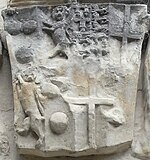
Back Guillaume de Courtenay (1475-1511) French William Courtenay, I conte di Devon Italian Куртене, Уильям, 1-й граф Девон Russian


Arms of William Courtenay, 1st Earl of Devon (d. 1511) above the south porch of St Peter's Church, Tiverton (detail). The arms are Courtenay impaling the arms of his wife's father as Duke of York: Quarterly 1st: Royal arms of Lionel, Duke of Clarence; second and third, Elizabeth de Burgh, 4th Countess of Ulster; fourth, Edmund Mortimer, 3rd Earl of March[2]

William Courtenay, 1st Earl of Devon (1475 – 9 June 1511), feudal baron of Okehampton and feudal baron of Plympton,[4] was a member of the leading noble family of Devon. His principal seat was Tiverton Castle, Devon with further residences at Okehampton Castle and Colcombe Castle, also in that county.
- ^ No marital relationship seems to have existed between the Courtenay and Speke families but the Courtenay arms may have been displayed simply in deference to the Earl as the most powerful man in Devon. Arms: Baron: quarterly 1st & 4th Courtenay, 2nd & 3rd de Redvers (lion should be azure not sable, possible restoration error) impaling femme: royal arms of King Edward IV (1461–1483), father of his wife Catherine of York (the sixth daughter of King Edward IV by Elizabeth Woodville). The Roses surrounding the escutcheon should be the White Rose of York not the Red Rose of Lancaster as shown here possibly due to erroneous restoration. The heraldic badge above (not the Courtenay crest of a plume of ostrich feathers) seems to have been adopted during the Wars of the Roses and depicts Jupiter, king of the gods, in guise of an eagle, holding in his claws a thunderbolt, the emblem of that deity. This is a well-known image often displayed on classical Greek and Roman coins. Mediaeval nobles frequently kept classical cameos and other valuables in their cabinets as curiosities, and thus the imagery would have been familiar.
- ^ These arms were also borne by Katherine's uncle Edmund of York, Earl of Rutland, 1443–1460 and by her half-brother Arthur Plantagenet, 1st Viscount Lisle (d. 1542), KG. The arms emphasise the descent of the Dukes of York from Lionel, Duke of Clarence (1338–1368), 3rd son of King Edward III, on which relationship their claim to the throne was based. http://www.richard111.com/house_of_york.htm
- ^ Surmounted by Jupiter, king of the gods, in guise of an eagle, holding in his claws a thunderbolt, the emblem of that deity, a Courtenay heraldic emblem also visible on the chancel arch of the church above the arms of his father. The eagle is flanked by two white roses of the House of York. The sinister supporter appears to be the Courtenay dolphin. This porch was erected with a chantry chapel in 1517 by John Greenway (1460–1529), a merchant of Tiverton, whose monogram is visible in the spandrels either side of the ogee arch. He added the Courtenay heraldry to his building as a sign of deference to the powerful Earl, lord of the manor of Tiverton, whose seat of Tiverton Castle was situated adjacent to the north of the church.
- ^ Pole, Sir William (d. 1635), Collections Towards a Description of the County of Devon, Sir John-William de la Pole (ed.), London, 1791, p.10

